Mastering sales funnel analysis: step-by-step guide, tools, and examples

You look at the closed deals and understand that your sales funnel just doesn’t deliver the results you need? You’re not alone, and the key to improvement is a thorough sales funnel analysis.
No optimization starts without proper analysis, and in this article, you’ll learn how to analyze your funnel step by step.
We’ll cover which:
- Mistakes to avoid;
- Which metrics to monitor;
- Which tools to leverage to make the process smoother.
By the end, you’ll have a clearer path to tackling those bottlenecks and enhancing your sales performance. Ready to transform your funnel into a robust system?
Let’s get started!
What sales funnel analysis is
Sales funnel analysis is a systematic approach to understanding and improving the journey your potential customers take from awareness to purchase. It involves examining each stage of the sales funnel to identify where prospects might get stuck or drop off, leading to missed sales opportunities.
This analysis helps businesses pinpoint bottlenecks and optimize the funnel for better conversion rates.
Businesses usually start a funnel analysis when they notice key indicators like declining conversion rates, a decrease in lead quality, or an increase in customer acquisition costs.
If you’re experiencing a higher-than-expected dropout rate at any stage of your funnel, or if your sales team closes few deals despite a steady flow of leads, it’s time to dive into a thorough sales funnel review.
But it doesn’t have to be problematic to look into it.
By conducting regular funnel analyses, you can uncover valuable insights into your customer journey, enabling you to refine strategies, enhance customer interactions, and ultimately, boost sales performance.
You can deal with a leaky sales funnel or just look for ways to maintain a well-oiled machine. Gathering the insights from a funnel analysis is essential for sustained growth and success.
Now let’s break down the sales stages 👇
Main stages of the sales funnel
Understanding the key stages of a sales funnel is crucial for effective funnel analysis. Each stage represents a different phase and intention in the prospective customer’s journey, requiring tailored strategies from your marketing and sales teams.
There are different approaches to sales funnel stages. In fact, it changes from one business to another.
But we’ll consider the five major stages:
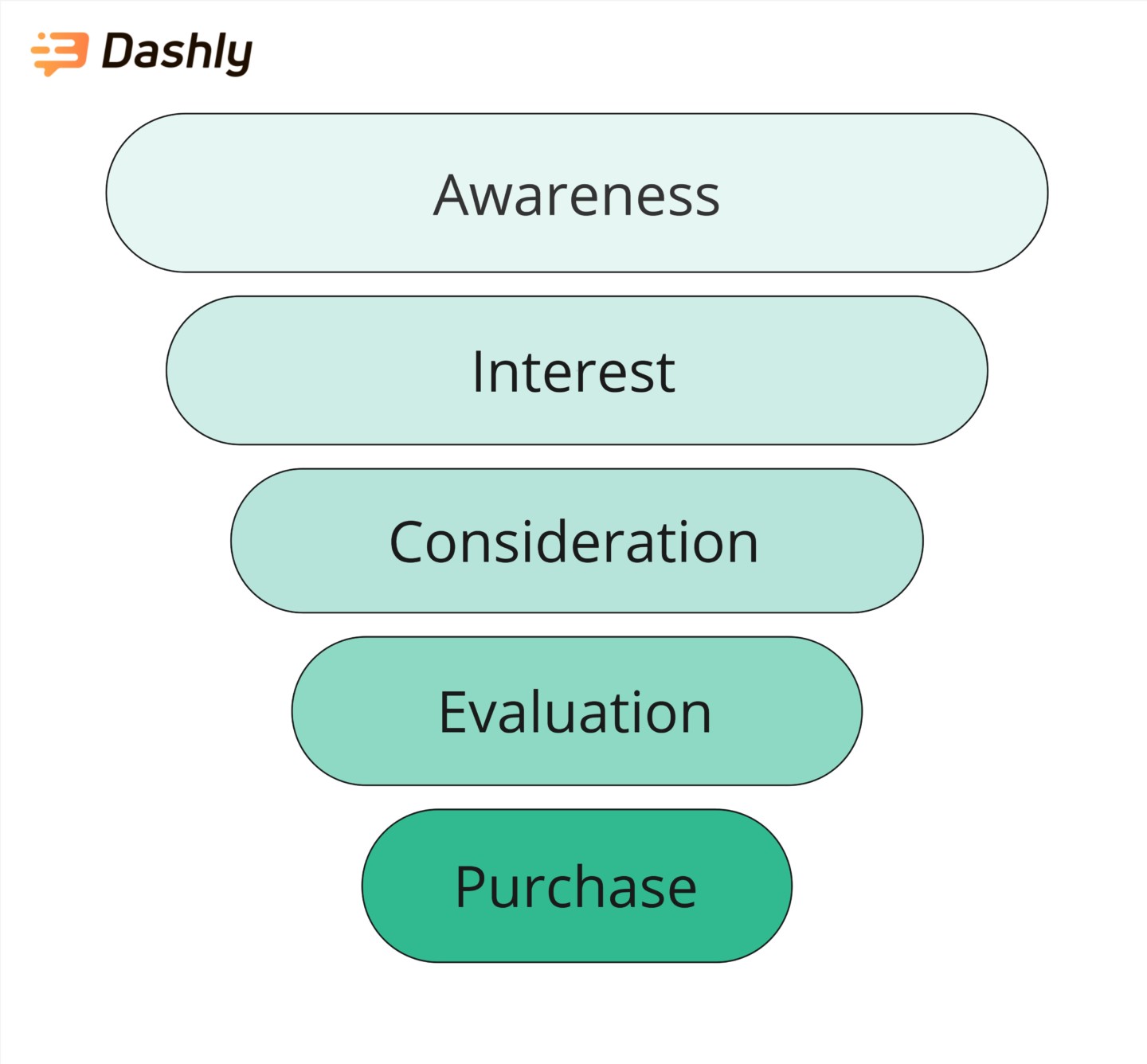
Awareness
In the Awareness stage, potential customers first encounter your brand.
They have a problem or need but are unaware of viable solutions. At this stage, your marketing team focuses on creating engaging content and campaigns to capture attention and introduce the brand.
Awareness requires building brand recognition. It helps draw leads to your website for further funnel analytics process.
Interest
The Interest stage is about prospects actively seeking information on solutions. They understand their pain points and are exploring options. Marketing’s role is to provide valuable content that highlights your brand’s offerings and advantages over competitors:
- Webinars,
- Blog posts,
- Newsletters.
This stage is vital for drawing prospects further into the funnel and prepping them for deeper engagement.
Consideration
At the Consideration phase you’re competing for prospect’s attention with all the similar solutions.
Leads might download whitepapers or attend product demos, seeking detailed insights. Here sales teams focus on personalized communication to highlight product benefits and value propositions tailored to each lead’s case. Effective analysis at this stage can identify which elements sway prospects towards a purchase.
Evaluation
After reading available content and going to demos, prospects are close to making a decision. They’re comparing costs and benefits, perhaps requesting quotes or trials.
Sales teams need to be proactive, offering tailored pricing options or personalized demos to meet specific needs. Careful funnel analysis and analytics at this stage help identify patterns in decision-making, guiding sales strategies.
Purchase
Finally, the Purchase stage is where the prospect becomes a customer. They’re ready to commit, and it’s crucial to ensure a seamless transaction.
Sales teams should focus on facilitating a smooth onboarding process and immediate support. Post-purchase, analysis continues. Its aim is understanding customer satisfaction and potential upsell opportunities.
By conducting thorough funnel and funnel analysis throughout these stages, businesses can optimize their strategies to better guide prospects through the sales funnel.
This detailed understanding helps in improving conversion rates and driving sales growth.
Read also: Top 15 Sales Funnel Software Tools to Boost Conversions in 2024
Benefits of funnel analysis
In case you’re still not convinced, let’s consider major advantages of conducting a thorough funnel analysis 😉 Let’s break down the most crucial of them:
- Identify bottlenecks: Funnel analyses help pinpoint stages where prospects drop off. By identifying these bottlenecks, businesses can implement targeted strategies to patch up leaky spots and keep leads moving through the funnel smoothly.
- Improve conversion rates: With funnel analytics, companies gain insights into what works and what doesn’t at each funnel stage. This allows for data-driven decisions to enhance the customer journey and boost conversion rates, ultimately leading to an increased number of closed sales deals.
- Enhance customer experience: By breaking down the customer journey, businesses can tailor their approaches to meet the specific needs of their audience. This leads to a more personalized and engaging CX.
- Optimize marketing strategies: Funnel analyses provide valuable insights into which marketing efforts are most effective. By analyzing this data, businesses can allocate resources more efficiently and focus on strategies that drive the highest return on investment.
- Align sales and marketing teams: A comprehensive funnel analysis encourages collaboration between sales and marketing teams. Aligning these departments ensures consistent work with prospects.
- Increase revenue: Ultimately, the insights gathered from funnel analytics contribute to more effective sales processes and higher conversion rates, leading to increased revenue and business success.
Embracing these benefits through regular funnel analysis can transform how businesses engage with their prospects, enhancing both short-term results and long-term growth.
How to conduct analysis of your funnel
So, since you are all ready for a sales funnel analysis, let’s go through our four-step action plan to help you effectively analyze your funnel* and optimize your sales processes.
Step 1: Map your sales funnel
Start by mapping out your entire sales funnel. Identify each stage in the customer journey, from awareness to purchase.
Understand what actions prospects take at each step, which content you provide, and how you reach out to them at each stage.
This clear visualization allows you to see where prospects may be dropping off or losing interest. By laying out these stages, you set the groundwork for effective analysis and analytics of potential bottlenecks.
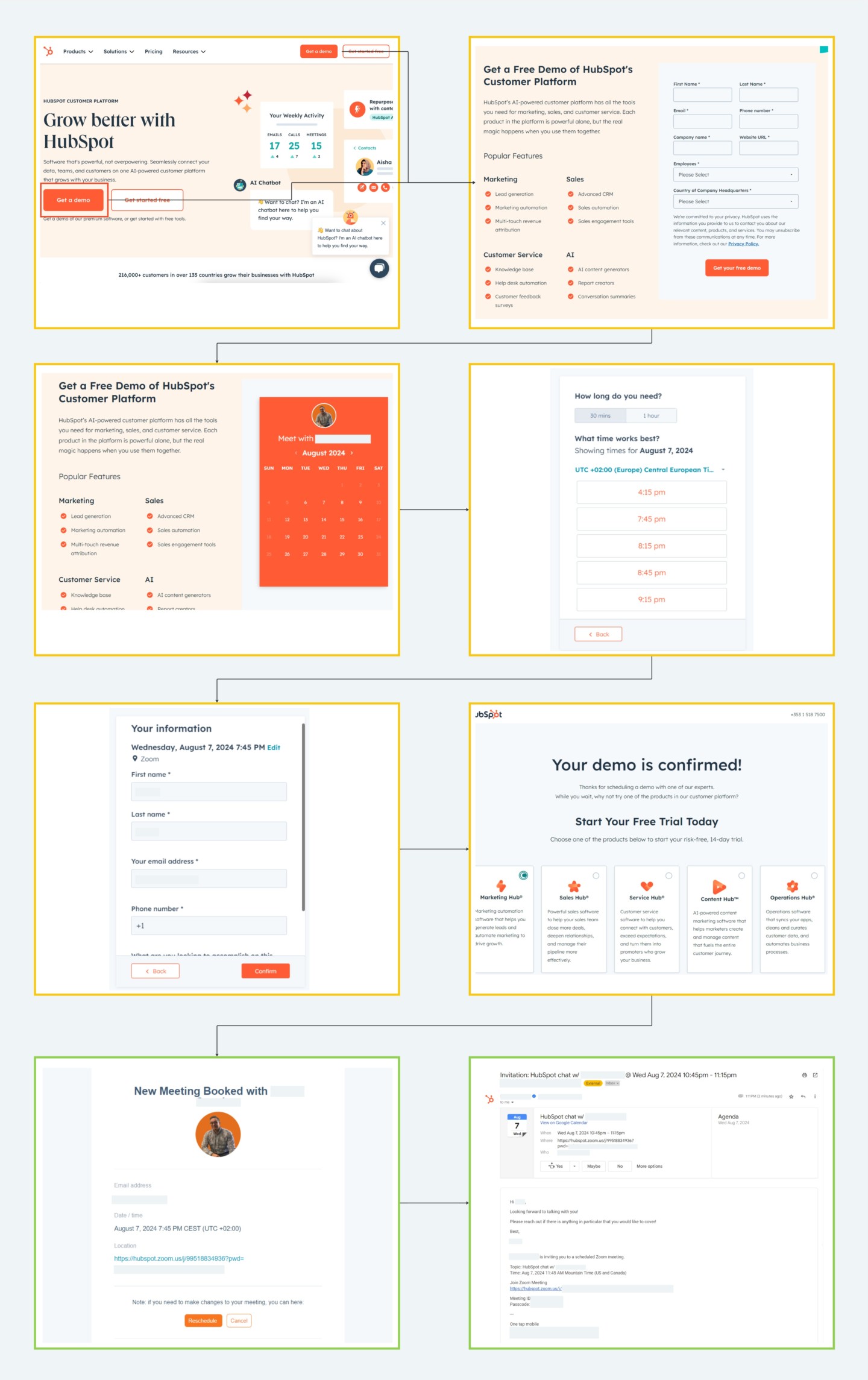
Step 2: Gather data
Once your funnel is mapped, it’s time for a deep dive into the data. Exciting but complicated journey.
Use your CRM and other analytical tools to collect information at each stage of the sales funnel. We’ll consider a few useful tools further in the article.
Key data to analyze:
- Conversion rates: Percentage of prospects moving to the next stage.
- Customer Acquisition Cost (CAC): The total cost of acquiring a new customer in your funnel.
- Lead quality: Characteristics of leads converting versus those who are not.
- Time to conversion: Average time taken to move from one stage to the next.
Gathering this data provides a clear quantitative and qualitative foundation for your funnel analysis, helping identify bottlenecks that need attention and also working strategies that are worth scaling.
Step 3: Analyze and identify pain points
With data in hand, you’re ready to find areas that require improvement.
Use funnel analytics to identify bottlenecks where prospects frequently drop off and examine the quality of leads at different stages. Investigate the reasons behind these issues. It could be ineffective messaging, lack of engagement, or insufficient follow-up.
This step requires a critical eye, as the goal is to uncover the root causes of inefficiencies within your sales funnel.
Step 4: Implement changes and monitor results
After identifying areas for improvement, it’s time to implement changes.
This might include refining your messaging, optimizing landing pages, improving content or communication strategies, or enhancing the personalization of outreach efforts.
Use A/B testing to try different approaches and see which bring the best results.
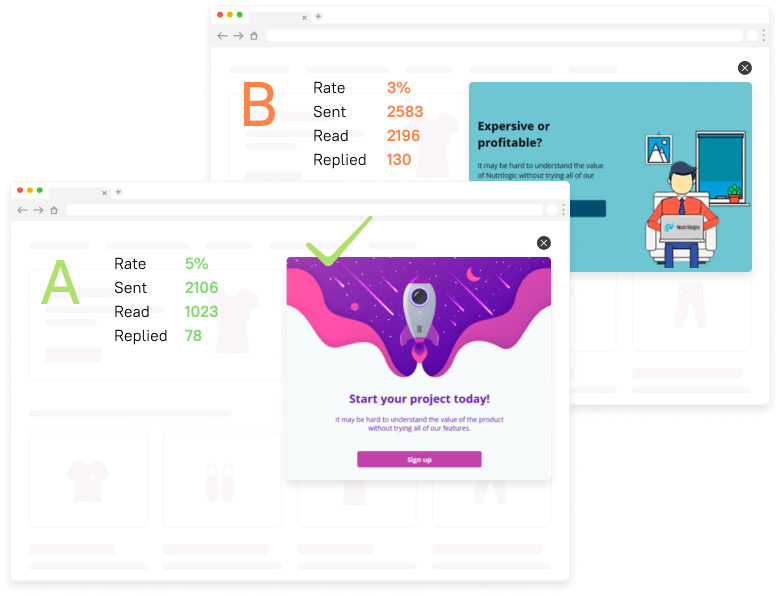
It’s crucial to monitor the impact of these changes using analytics tools, allowing you to tweak strategies as needed and ensure continued optimization of your sales funnel.
Conducting a sales funnel analysis is a dynamic process that requires careful planning, data gathering, and strategy adjustment.
By following these four steps, you can systematically and regularly analyze your funnel, identify problem areas, and implement targeted improvements that boost conversion rates and sales performance.
Remember, that analysis is not a one time thing. Keep testing and refining your approach to maintain a robust and effective sales funnel.
This iterative process not only improves current performance but also equips your business to adapt swiftly to future challenges and opportunities.
Funnel analysis mistakes to avoid
While conducting a sales funnel analysis can provide invaluable insights, it’s easy to fall into some common pitfalls. Here are key mistakes to avoid to ensure an effective funnel analysis:
- Ignoring data quality: One of the biggest mistakes teams make is relying on poor-quality data. Incomplete or inaccurate data can mislead your funnel analysis, resulting in misguided decisions. Always ensure your data sources are reliable and up-to-date, and regularly audit your CRM and analytics tools for accuracy.
- Focusing solely on conversion rates: While conversion rates are critical, obsessing over them without considering other metrics can lead to an incomplete picture of your sales funnel. Look at a range of metrics, such as lead quality, customer acquisition cost, and time to conversion, to gain a holistic understanding. These insights can often reveal underlying issues not evident in conversion rates alone.
- Overlooking customer feedback: Relying solely on quantitative data without considering customer feedback can be a misstep. Qualitative insights from customer surveys, interviews, and support tickets can provide context to the numbers you see. Listening to customer feedback helps identify pain points in the funnel that data alone might not reveal.
- Failure to align sales and marketing: You can’t carry out an analysis only within a marketing or sales team. It can cause inconsistencies in strategy, affecting your sales funnel performance. Both teams should collaborate closely during the funnel analysis process to ensure you have all the data to draw conclusions and make decisions.
- Not testing improvements: Implementing changes without testing them is a common mistake. Any adjustments made based on your funnel analysis should be tested first. Whether it’s A/B testing or anything else. This ensures that you apply changes that drive the best results and lead to improved sales performance.
By avoiding these mistakes, you can conduct a more effective funnel analysis, leading to better decision-making and a more optimized sales funnel. The goal is to create a seamless journey for your prospects, informed by comprehensive data and insights that truly reflect the customer experience.
Funnel analytics metrics
As already mentioned, you need to consider various metrics within your sales funnel analysis. Now it’s finally time to consider an extended list of numbers you should track:
- Conversion rate: This metric tracks the percentage of prospects who move from one stage of the sales funnel to the next. It’s vital for understanding how effectively your funnel converts leads into customers. A low conversion rate may indicate a need for better engagement strategies or improved messaging.
- Lead drop-off rate: This shows the percentage of leads lost at each stage of the funnel. High drop-off rates can signal issues with your customer journey, such as unclear CTAs or insufficient follow-up. Understanding where prospects lose interest helps you refine those stages.
- Time to conversion: The average time it takes for a lead to move from initial contact to purchase. A lengthy conversion time in funnel analytics might indicate inefficiencies in your funnel, such as overly complicated processes or delayed responses. But measure this time considering the type of business. Often B2B deals take months to close.
- Customer acquisition cost (CAC): CAC measures the total cost of acquiring a new customer, including marketing and sales expenses. High acquisition costs might mean you need to optimize your marketing channels or sales strategies to ensure the expenses are justified by the returns.
- Average deal size: Average revenue generated per transaction. Monitoring this helps determine the profitability of each sale, guiding pricing strategies and efforts to upsell or cross-sell within the funnel.
- Retention rate: The percentage of customers who continue to engage with your product or service over time. A high retention rate suggests effective follow-up and customer satisfaction, while a low rate might indicate post-purchase issues that need addressing (this might include onboarding, customer service or failure in delivering value).
By keeping a close eye on these funnel analytics metrics, businesses can gain valuable insights into the performance of their sales funnel. This empowers teams to make data-driven decisions that optimize the customer journey, enhance engagement, and drive sales growth.
Funnel analysis examples
Let’s consider a fictional SaaS company, “DataStream Solutions,” specializing in data analytics software.
Recently, they’ve noticed a significant issue: very few leads attend their demo meetings. This drop-off is hurting their sales funnel performance and conversion rates.
Here’s a step-by-step plan on how they can conduct a funnel analysis and draw conclusions for enhancements 👇
Step 1: Identify the problem
DataStream Solutions starts by mapping out their entire sales funnel to identify where the drop-off occurs. They discover that a large number of prospects book a demo but fail to attend the scheduled meeting.
This awareness prompts a deeper analysis of the demo booking process
Step 2: Gather Data
Using funnel analytics, the team collects data on each step leading to the demo. They examine metrics such as demo booking rates, no-show rates, and communication touchpoints. Again, you can’t do it without qualitative data 😉
Step 3: Analyze the Data
Through analysis, the team discovers that prospects often miss demos due to unclear scheduling or lack of reminders. Additionally, some feedback reveals that prospects feel unprepared or unsure of what to expect from the demo.
This indicates a need for clearer communication and engagement strategies.
Step 4: Implement Changes
Based on their funnel analysis, DataStream Solutions decides to implement several enhancements:
- Introduce automated email reminders and text notifications to ensure prospects remember their scheduled demos.
- Provide prospects with a brief agenda and benefits of attending the demo, helping set expectations and illustrate value.
- Allow for easy rescheduling options to accommodate changing prospect availability.
After implementing these changes, DataStream Solutions’ sales teams confirmed an increase in demo attendance, leading to improved conversion rates in their sales funnel.
By conducting a thorough funnel analysis and addressing the identified issues, they enhance their sales process and ensure a smoother transition from lead to customer.
If you have a similar problem as DataStream Solutions and struggle to raise your demo attendance rates, Dashly’s ready to help 👇
Double your SaaS sales funnel conversion with Dashly AI
⭐ Engage prospects with conversational quiz
⭐ Reach out in their preferrable channel
⭐ Automate lead nurturing with personalized AI sequences
Analytics tools
Choosing the right tools for funnel analysis can significantly enhance your understanding of customer behavior and optimize your sales funnel. I’ve already teased them before, so please welcome your loyal helpers on your analysis journey 🗺️
Google Analytics
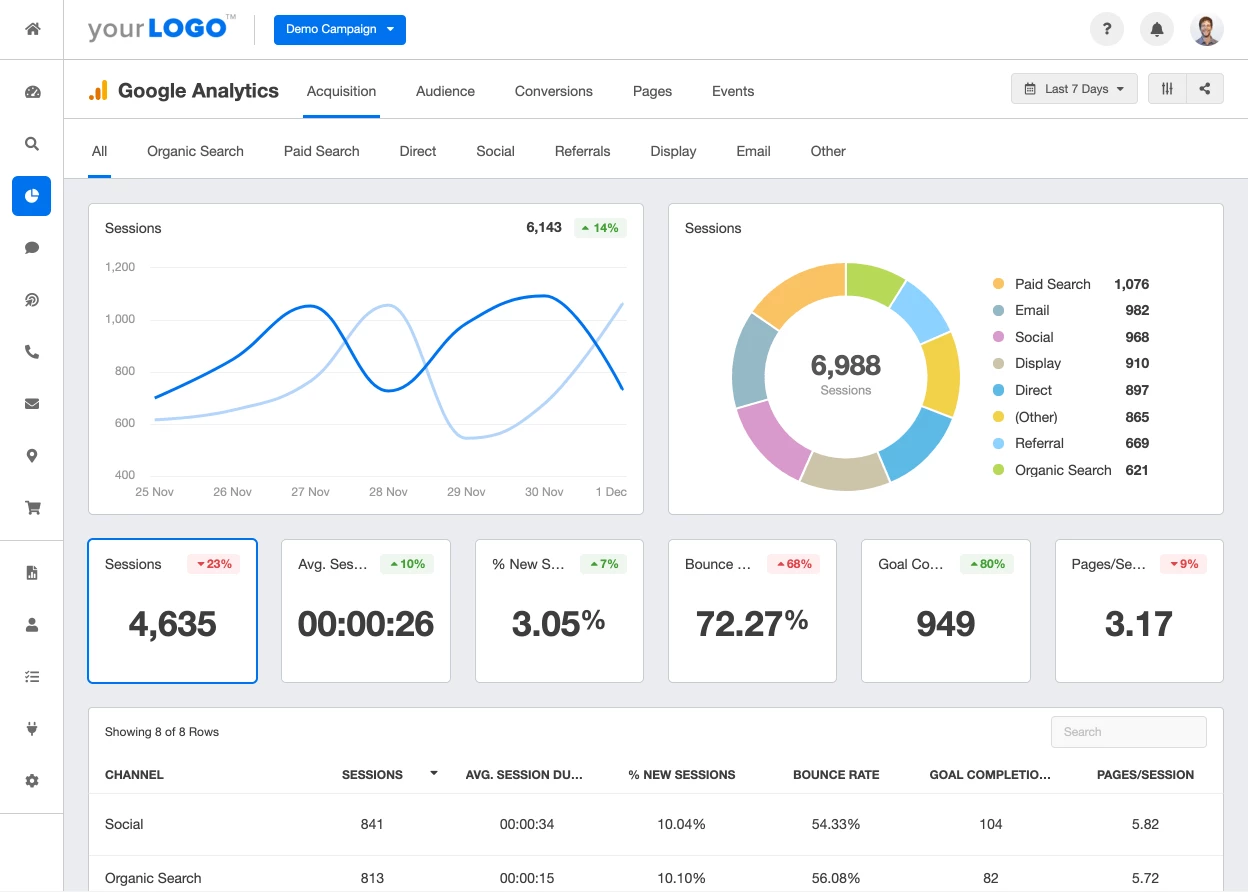
Google Analytics is a must-have tool that offers comprehensive insights into website traffic and user behavior. It provides a wealth of data to help you understand how visitors interact with your site and navigate your sales funnel.
What it can help you with
- Track visitor behavior: Understand how users move through your site, which pages they visit, and how long they stay.
- Analyze traffic sources: Discover where your traffic is coming from, be it organic, paid, or referral, to optimize inbound strategies (or introduce outbound ones).
- Monitor conversion goals: Set up goals to track conversions and see where users drop off in your funnel.
- Evaluate audience segments: Break down data by demographics, interests, and behavior for more targeted marketing.
Mixpanel
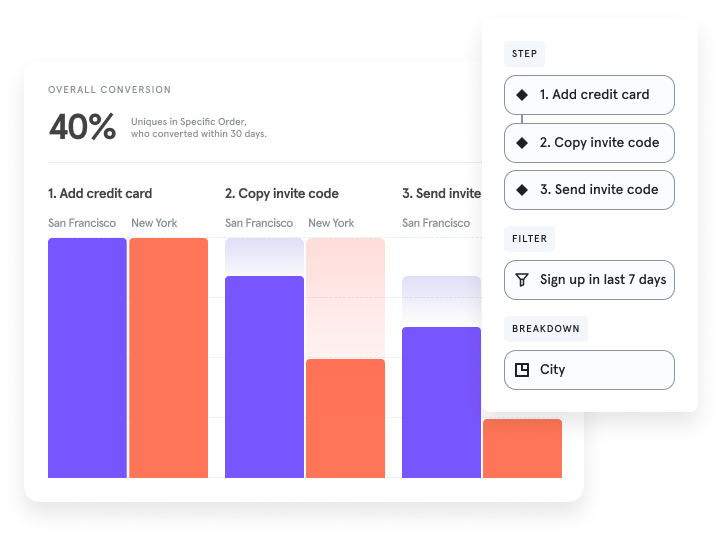
Mixpanel is a user analytics platform focused on understanding user interactions with your product. It provides detailed insights into user engagement and sales processes, making it ideal for SaaS companies seeking in-depth funnel analysis.
What it can help you with
- Track user flows: Visualize user paths through your product to identify common drop-off points.
- Engage with cohort analysis: Segment users based on specific behaviors to see how different groups interact with your funnel.
- Conduct A/B testing: Test variations of product features or messages to see what resonates best with users.
- Create retention reports: Analyze how many users keep using your product, helping you understand long-term engagement.
Crazy Egg
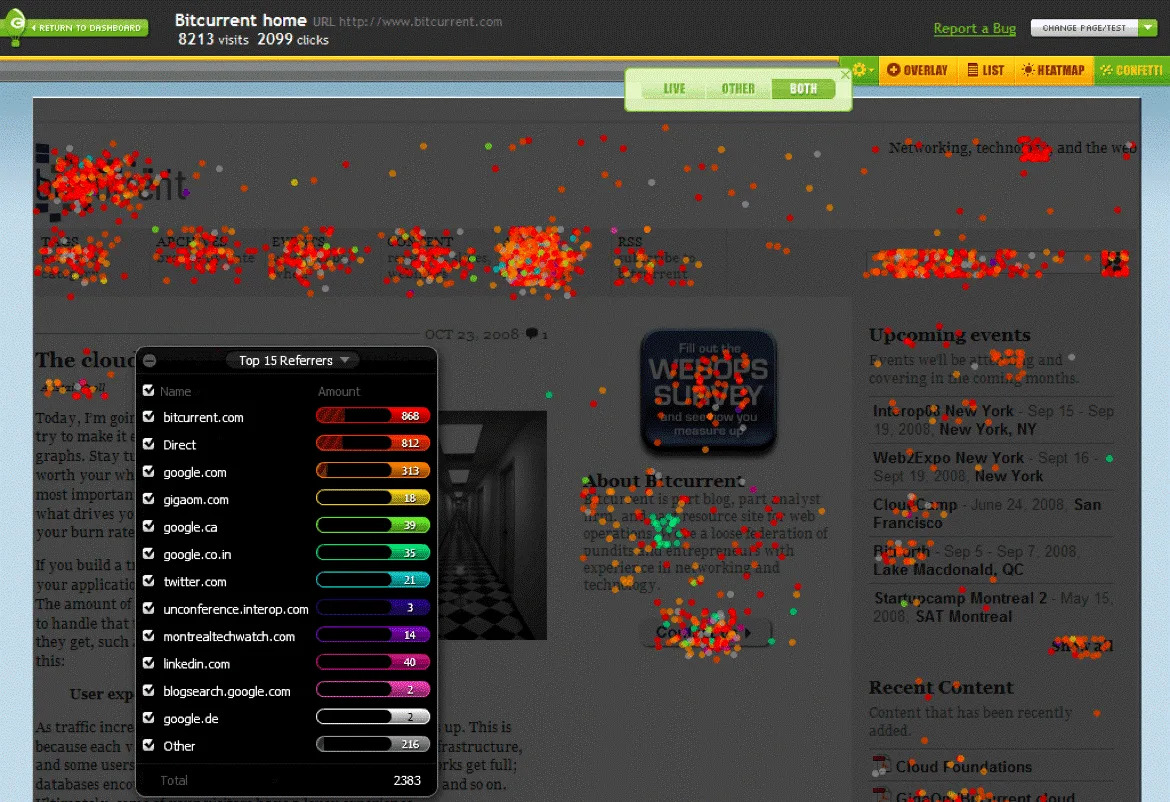
Crazy Egg offers visual tools that allow you to see how visitors interact with your website through heatmaps and user recordings. It’s perfect for identifying UI and UX improvements that can enhance your sales funnel.
What it can help you with
- Heatmaps: Visualize where users click, scroll, and hover on your pages to identify areas of interest or confusion.
- Scrollmaps: Discover how far users scroll down on a page to determine if important content is missed.
- A/B testing: Experiment with different page designs or layouts to improve user experience and engagement.
- User recordings: Watch recordings of user sessions to gain insights into real user behavior and identify friction points.
Each of these tools provides unique insights that can elevate your sales funnel management. By leveraging their capabilities, you’ll be equipped to conduct thorough funnel analysis, lead more effective sales strategies, and ultimately boost your conversion rates.
Final thoughts on analysis
Conducting a sales funnel analysis is crucial for understanding and improving customer journeys. It empowers businesses to identify bottlenecks and optimize processes. Remember to:
- Always ask questions about your funnel performance;
- Continuously seek new ways to enhance conversions;
- Keep refining your sales funnel for sustained success.
Regular analysis will lead to more effective sales strategies and growth. Keep exploring and innovating!
Double your SaaS sales funnel conversion with Dashly AI
⭐ Engage prospects with conversational quiz
⭐ Reach out in their preferrable channel
⭐ Automate lead nurturing with personalized AI sequences
FAQ
A sales funnel analysis involves examining each stage of your sales funnel to identify where prospects drop off and why. This analysis helps businesses optimize their funnel by highlighting inefficiencies and areas for improvement, ultimately enhancing conversions and boosting sales.
Funnel analysis is crucial because it provides insights into the customer journey, helping you pinpoint bottlenecks and optimize for better results. By understanding how prospects move down your funnel, you can refine your strategies, improve conversion rates, and increase overall sales performance.
Key metrics to monitor include conversion rates, lead drop-off rates, customer acquisition costs, time to conversion, and retention rates. These metrics provide a comprehensive view of how effective your sales funnel is and where improvements are needed.
Regularly conduct a funnel analysis to ensure optimal performance. Ideally, review your sales funnel monthly or quarterly. Frequent analysis helps you catch issues early and allows for timely adjustments based on data-driven insights.
Tools like Google Analytics, Mixpanel, and Crazy Egg are invaluable for funnel analysis. They offer insights into user behavior, track conversions, and help visualize how prospects interact with your site. These tools provide the data needed to make informed decisions and enhance your sales strategies.


![Top 10 Best Custom Chatbot Platforms for your website [+AI]](https://www.dashly.io/blog/wp-content/uploads/2020/06/cover-1-720x308.jpg)


![La guía definitiva de growth marketing [explicada por un growth hacker]](https://www.dashly.io/blog/wp-content/uploads/2023/04/The-ultimate-guide-to-growth-marketing-explained-by-a-growth-hacker-720x317.png)


